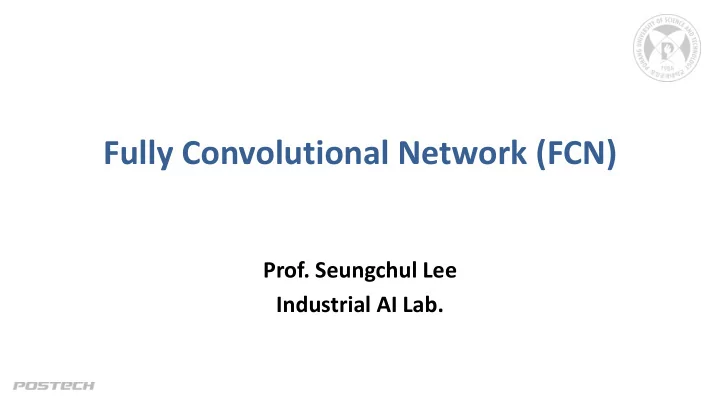

Fully Convolutional Network (FCN) Prof. Seungchul Lee Industrial AI Lab.
Deep Learning for Computer Vision: Review Source: 6.S191 Intro. to Deep Learning at MIT 2
Segmentation • Segmentation task is different from classification task because it requires predicting a class for each pixel of the input image, instead of only 1 class for the whole input. • Segment images into regions with different semantic categories. These semantic regions label and predict objects at the pixel level Image from http://d2l.ai/ 3
Segmentation • Segmentation task is different from classification task because it requires predicting a class for each pixel of the input image, instead of only 1 class for the whole input. • Segment images into regions with different semantic categories. These semantic regions label and predict objects at the pixel level • Classification needs to understand what is in the input (namely, the context). • However, in order to predict what is in the input for each pixel, segmentation needs to recover not only what is in the input, but also where. Image from http://d2l.ai/ 4
Semantic Segmentation: FCNs • FCN uses a convolutional neural network to transform image pixels to pixel categories. • Network designed with all convolutional layers, with down-sampling and up-sampling operations • Given a position on the spatial dimension, the output of the channel dimension will be a category prediction of the pixel corresponding to the location. Image from http://d2l.ai/ 5
From CAE to FCN 6
From CAE to FCN 7
Skip Connection • A skip connection is a connection that bypasses at least one layer. • Here, it is often used to transfer local information by summing feature maps from the downsampling path with feature maps from the upsampling path. – Merging features from various resolution levels helps combining context information with spatial information. 8
Fully Convolutional Networks (FCNs) • To obtain a segmentation map (output), segmentation networks usually have 2 parts – Downsampling path: capture semantic/contextual information – Upsampling path: recover spatial information • The downsampling path is used to extract and interpret the context (what), while the upsampling path is used to enable precise localization (where). • Furthermore, to fully recover the fine-grained spatial information lost in the pooling or downsampling layers, we often use skip connections. • Network can work regardless of the original image size, without requiring any fixed number of units at any stage. 9
Segmented (Labeled) Images input output output 10
FCN Architecture maxp3 maxp4 fcn4 fcn3 fcn2 fcn1 Fixed Trained 11
FCN Architecture maxp3 maxp4 fcn4 fcn3 fcn2 fcn1 Fixed Trained 12
FCN Architecture maxp3 maxp4 fcn4 fcn3 fcn2 fcn1 Fixed Trained 13
FCN Architecture maxp3 maxp4 fcn4 fcn3 fcn2 fcn1 Fixed Trained 14
Segmentation Result maxp3 maxp4 15
Recommend
More recommend